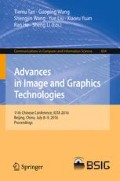Abstract
An effective image content temper detection scheme that uses perfect hash model is proposed in this paper. Aiming at low detection failing rates and high detection successful rates in image tamper localization, the proposed scheme uses perfect hash model to overcome easy collisions of the random numbers to enhance the effectiveness in authentication procedure. This scheme embeds perfect hash information in the LSBs of the original image to protect image content. The experimental results demonstrate that the proposed scheme has a good performance and can be used for image authentication applications.
Access this chapter
Tax calculation will be finalised at checkout
Purchases are for personal use only
References
Venkatesan, R., Koon, S.M., Jakubowski, M.H., Moulin, P.: Robust image hashing. In: Proceedings of IEEE International Conference on Image Processing, vol. 3, pp. 664–666 (2000)
Fridrich, J., Goljan, M.: Robust hash functions for digital watermarking. In: Proceedings of IEEE International Conference on Information Technology: Coding and Computing, pp. 178–183 (2000)
Tagliasacchi, M., Valenzise, G., Tubaro, S.: Hash-based identification of sparse image tampering. IEEE Trans. Image Process. 18(11), 2491–2504 (2009)
Ahmed, F., Siyal, M.Y., Uddin Abbas, V.: A secure and robust hash-based scheme for image authentication. Sig. Process. 90(5), 1456–1470 (2010)
Lei, Y., Wang, Y., Huang, J.: Robust image hash in Radon transform domain for authentication. Sig. Process. Image Commun. 26(6), 280–288 (2011)
Zhao, Y., Wang, S., Zhang, X., Yao, H.: Robust hashing for image authentication using Zernike moments and local features. IEEE Trans. Inf. Forensics Secur. 8(1), 55–63 (2013)
Wu, M., Liu, B.: Watermarking for image authentication. In: Proceedings of IEEE International Conference on Image Processing, ICIP 1998, vol. 2, pp. 437–441 (1998)
Kundur, D., Hatzinakos, D.: Digital watermarking for telltale tamper proofing and authentication. Proc. IEEE 87(7), 1167–1180 (1999)
Yang, L., Ni, R., Zhao, Y.: Segmentation-based image authentication and recovery scheme using reference sharing mechanism. In: 2012 International Conference on Industrial Control and Electronics Engineering, ICICEE 2012, pp. 863–866 (2012)
Preda, R.O.: Semi-fragile watermarking for image authentication with sensitive tamper localization in the wavelet domain. Measurement 46(1), 367–373 (2013)
Chang, C.C., Fan, Y.H., Tai, W.L.: Four-scanning attack on hierarchical digital watermarking method for image tamper detection and recovery. Pattern Recognit. 41(2), 654–661 (2008)
Rawat, S., Raman, B.: A chaotic system based fragile watermarking scheme for image tamper detection. AEU-Int. J. Electron. Commun. 65(10), 840–847 (2011)
Tong, X., Liu, Y., Zhang, M., Chen, Y.: A novel chaos-based fragile watermarking for image tampering detection and self-recovery. Signal Process.: Image Commun. 28(3), 301–308 (2012)
Lee, C.W., Tsai, W.H.: A data hiding method based on information sharing via PNG images for applications of color image authentication and metadata embedding. Signal Process. 93(7), 2010–2025 (2013)
Sprugnoli, R.: Perfect hashing functions: a single probe retrieving method for static sets. Commun. ACM 20(11), 841–850 (1977)
Du, M.W., Hsieh, T.M., Jea, K.F., Shieh, D.W.: The study of a new perfect hash scheme. IEEE Trans. Softw. Eng. SE-9(3), 305–313 (1983)
Tang, Z., Zhang, X., Dai, X., Yang, J., Wu, T.: Robust image hash function using local color features. AEU-Int. J. Electron. Commun. 67(8), 717–722 (2013)
Byun, S.C., Lee, I.L., Shin, T.H., Ahn, B.H.: A public-key based watermarking for color image authentication. In: IEEE International Conference on Multimedia and Expo, vol. 1, pp. 593–596 (2002)
Author information
Authors and Affiliations
Corresponding author
Editor information
Editors and Affiliations
Rights and permissions
Copyright information
© 2016 Springer Science+Business Media Singapore
About this paper
Cite this paper
Sun, J., Lyu, WL. (2016). A Perfect Hash Model Used for Image Content Tamper Detection. In: Tan, T., et al. Advances in Image and Graphics Technologies. IGTA 2016. Communications in Computer and Information Science, vol 634. Springer, Singapore. https://doi.org/10.1007/978-981-10-2260-9_25
Download citation
DOI: https://doi.org/10.1007/978-981-10-2260-9_25
Published:
Publisher Name: Springer, Singapore
Print ISBN: 978-981-10-2259-3
Online ISBN: 978-981-10-2260-9
eBook Packages: Computer ScienceComputer Science (R0)

